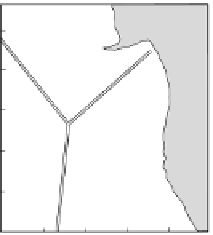Geoscience Reference
In-Depth Information
Problems
Plate D
1. All plates A-D shown in Fig. 2.22 move rigidly without rotation. All ridges add at
equal rates to the plates on either side of them; the rates given on the diagram are
half the plate-separation rates. The trench forming the boundary of plate A does not
consume A.
J
Plate
A
o
155
Plate C
3 cm yr
−
1
3 cm yr
−
1
Plate B
Use the plate velocities and directions to determine by graphical means or otherwise
(a) the relative motion between plates B and D and (b) the relative motion between the
triple junction J and plate A. Where and when will J reach the trench? Draw a sketch
of the geometry after this collision showing the relative velocity vectors and discuss
the subsequent evolution. (From Cambridge University Natural Sciences Tripos 1B,
1982.)
2. Long ago and far away in a distant galaxy lived two tribes on a
flat
planet known as
Emit-on (Fig. 2.23). The tribe of the dark forces lived on the islands in the cold parts
of the planet near A, and a happy light-hearted people lived on the sunny beaches
near B. Both required a constant supply of fresh andesite to survive and collected the
shrimp-like animals that prospered near young magnetic-anomaly patterns, for their
food. Using the map and your knowledge of any other galaxy, predict the future of
these tribes. (From Cambridge University Natural Sciences Tripos 1B, 1980.)
45
o
8.5 cm yr
−
1
2000 km
Figure 2.22.
A map of
part of a flat planet.
AMNESIA
PLATE
A
COOLER
PLATE
FAR-OUT-MAN
PLATE
BEAUTIFIC
PLATE
3. Use the map in Fig. 2.2 to do the following.
(a) Calculate the relative present-day motions at the tabulated locations, using or cal-
culating the appropriate poles from those given in Table 2.1.
(b) Plot the azimuth and magnitude of these relative motions on the map.
(c) Plot the pole positions. Note how the relative motions change along plate boundaries
as the angular distance from the pole changes.
(d) Discuss the nature of the plate boundary between the Indian/Australian and Pacific
plates.
(e) Discuss the nature of the plate boundary between the Eurasian and African plates
between the Azores and Gibraltar. How does this boundary differ in the Mediter-
ranean?
(From G. C. P. King, personal communication.)
B
1000 km
Figure 2.23.
A map of
part of Emit-on.
Latitude
Longitude
Location
54
◦
N
169
◦
E
W. Aleutian Trench
52
◦
N
169
◦
W
E. Aleutian Trench
38
◦
N
122
◦
W
San Francisco-San Andreas Fault
26
◦
N
110
◦
W
Gulf of California
13
◦
S
112
◦
W
East Pacific Rise
36
◦
S
110
◦
W
East Pacific Rise
59
◦
S
150
◦
W
Antarctic-Pacific Ridge
45
◦
S
169
◦
E
S. New Zealand
55
◦
S
159
◦
E
Macquarrie Island
52
◦
S
140
◦
E
Southeast Indian Ridge
(
cont.
)

















































